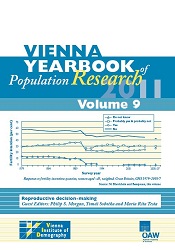 |
 |
Vienna Institute of Demography (Ed.)
Vienna Yearbook of Population Research 2011
Dimiter Philipov
S. 37 - 45 doi: 10.1553/populationyearbook2011s37
Verlag der Österreichischen Akademie der Wissenschaften
2012/02/02 14:40:33 Document Date:
2015/02/12 07:59:05 Object Identifier:
0xc1aa5576 0x002a70f0
Rights:All rights reserved.For questions regarding copyright and copies please contact us by email.
Introduction
Maria Rita Testa, Tomás Sobotka and Philip S. Morgan: Reproductive decision-making: towards improved theoretical,
methodological and empirical approaches.
Demographic Debate
S. Philip Morgan and Christine A. Bachrach: Is the Theory of Planned Behaviour an appropriate model for human
fertility?
Warren B. Miller: Comparing the TPB and the T-D-I-B framework
Jennifer Barber: The Theory of Planned Behaviour: considering drives, proximity and
dynamics
Dimiter Philipov: Theories on fertility intentions: a demographer's perspective
Jane Klobas: The Theory of Planned Behaviour as a model of reasoning about fertility
decisions
Aart C. Liefbroer: On the usefulness of the Theory of Planned Behaviour for fertility
research
Icek Ajzen: Reflections on Morgan and Bachrach's critique
Christine A. Bachrach and S. Philip Morgan: Further reflections on the Theory of Planned Behaviour and fertility
research
Refereed Articles
Warren B. Miller: Differences between fertility desires and intentions: implications for theory,
research and policy
Máire Ní Bhrolcháin and Éva Beaujouan: Uncertainty in fertility intentions in Britain, 1979–2007
Saskia Hin, Anne Gauthier, Joshua Goldstein and Christoph Bühler: Fertility preferences: what measuring second choices teaches us
Maria Rita Testa, Laura Cavalli and Alessandro Rosina: Couple´s childbearing behaviour in Italy: which of the partners is leading
it?
Nicoletta Balbo and Melinda Mills: The influence of the family network on the realisation of fertility
intentions
Markus Kotte and Volker Ludwig: Intergenerational transmission of fertility intentions and behaviour in Germany: the role of contagion
David De Wachter and Karel Neels: Educational differentials in fertility intentions and outcomes: family
formation in Flanders in the early 1990s
Clémentine Rossier, Sara Brachet and Anne Salles: Family policies, norms about gender roles and fertility decisions in France
and Germany
Anna Rotkirch, Stuart Basten, Heini Väisänen and Markus Jokela: Baby longing and men's reproductive motivation
Anna Baranowska and Anna Matysiak: Does parenthood increase happiness? Evidence for Poland
Data and Trends (non-refereed contributions)
Jennifer S. Barber, Yasamin Kusunoki and Heather Gatny : Design and implementation of an online weekly survey to study unintended
pregnancies
Beatrice Chromková Manea and Petr Fucík: Couples disagreement about fertility preferences and family-friendly policy
measures in the Czech Republic
|
|
|
REFERENCES |
|
|
Barber, Jennifer S. 2001. Ideational influences on the transition to parenthood: attitudes towards childbearing and competing alternatives. Social Psychology Quarterly 64(2): 101-127.
|
|
|
Barber, Jennifer S., Warren B. Miller and Heather H. Gatny 2010. The desire to become pregnant and the desire to avoid pregnancy: ambivalence, indifference, pronatalism and antinatalism. Paper presented at the annual VID Conference From Intentions to Behaviour: Reproductive Decision-Making in a Micro-Macro- Perspective.
|
|
|
Billari F., D. Philipov and M.R. Testa 2009. Attitudes, norms and perceived behavioural control: explaining fertility intentions in Bulgaria. European Journal of Population 25(4): 439-466.
|
|
|
De Bruijn, B. 1999. Foundations of demographic theory: choice, process, context. Doctoral dissertation published in the PDOD publication series A. NethurD Publications.
|
|
|
Festinger L. 1957. A theory of cognitive dissonance. Stanford, Ca.: Stanford University Press.
|
|
|
Fishbein, M. and I. Ajzen 2010. Predicting and changing behavior: the reasoned action approach. New York: Psychology Press.
|
|
|
Hagewen, K. and S.P. Morgan 2005. Intended and ideal family size in the U.S., 1970- 2002. Population and Development Review 31(3): 507-528.
|
|
|
Liefbroer, A. 2009. Changes in family size intentions across young adulthood: a lifecourse perspective. European Journal of Population 25:363-386.
|
|
|
Miller W.B. and D.J. Pasta 1993. Motivational and non-motivational determinants of child-number desires. Population and Environment: A Journal of interdisciplinary Studies 15: 113-138.
|
|
|
Miller W.B. and D.J. Pasta 1994. The psychology of child timing: a measurement instrument and a model. Journal of Applied Social Psychology 24: 218-250.
|
|
|
Miller W.B. and D.J. Pasta 1995. Behavioural intentions: which ones predict fertility behaviour in married couples? Journal of Applied Social Psychology 25: 530-555.
|
|
|
Miller, W.B. 2011. Comparing the TPB and the T-D-I-B framework. Vienna Yearbook of Population Research Vol 9:19-29.
|
|
|
Moors, Guy 2008. The valued child. In search of a latent attitude profile that influences the transition to motherhood. European Journal of Population 24: 33-57.
|
|
|
Morgan, S.P. and H. Rackin 2010. The correspondence between fertility intentions and behavior in the United States. Population and Development Review 36(1): 91-118. Philipov, Dimiter 2009. The effect of competing intentions and behaviour on short-term childbearing intentions and subsequent childbearing. European Journal of Population 25,4: 525-548.
|
|
|
Quesnel-Vallée, A. and S.P. Morgan 2003. Missing the target? Correspondence of fertility intentions and behavior in the U.S. Population Research and Policy Review 22(5-6): 497-525.
|
|
|
Spéder, Z. and B. Kapitány 2009. How are time-dependent childbearing intentions realized? Realization, postponement, abandonment, bringing forward. European Journal of Population 25(4): 503-523.
|
|
|
Westoff, C. and N.B. Ryder 1977. The predictive validity of reproductive intentions. Demography 14(4): 431-453.
|
Inhaltsverzeichnisse und Leseproben sind frei zugänglich. Tables of Contents and Reading examples are freely accessible.
Vergessen Sie nicht das
Login am Server, wenn Sie auf Kapitel zugreifen wollen, die nicht allgemein zugänglich sind.
Links zu diesen Dokumenten werden erst nach dem Login sichtbar.
Do not forget to Login on the server if you want to access chapters that are not freely accessible.
Links to these documents will only be visible after logon.




 Home
Home Print
Print
 References
References
 Share
Share
